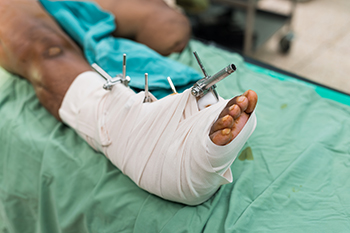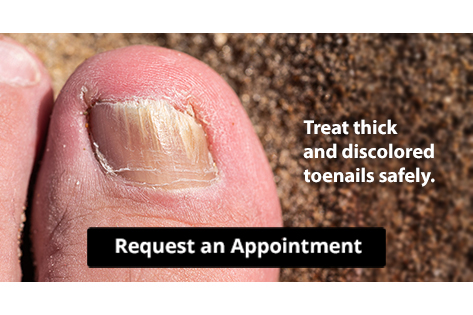Items filtered by date: October 2025
The Impact of Wearing the Wrong Shoe Size

Wearing shoes that do not fit properly can cause a range of painful foot problems. Shoes that are too tight may lead to blisters, bunions, hammertoes, and corns, in addition to ingrown toenails, and sore arches. Shoes that are too large can cause inadequate ankle support, increasing the risk of ankle sprains and instability. Poorly fitted footwear also alters the way you walk, which can lead to long-term joint or posture issues. A podiatrist can assess your feet, recommend the correct shoe size and style, and provide treatments for any existing conditions caused by improper footwear. If you have foot pain or a specific condition from wearing the wrong shoe size, it is suggested that you consult a podiatrist who can treat various foot conditions, and guide you on the correct size shoes to wear.
Getting the right shoe size is an important part of proper foot health. Seek the assistance of one of our doctors from Hamilton Foot and Ankle Associates. Our doctors will provide the care you need to keep you pain-free and on your feet.
Getting the Right Shoe Size
There are many people who wear shoes that are the incorrect size, negatively affecting their feet and posture. Selecting the right shoes is not a difficult process, so long as you keep several things in mind when it comes to choosing the right pair.
- When visiting the shoe store, use the tools available to measure your foot.
- Be sure there is ‘wiggle room’. There should be about an inch between your toes and the tip of your shoes.
- Do not always assume you are the same size, as manufacturers run differently.
- Purchase shoes later in the day, as your feet swell as the day progresses.
- If a shoe is not comfortable, it is not suitable. Most shoes can’t be ‘broken in’, and comfort should be the ultimate goal when it comes to choosing the right pair of shoes
As our feet hold our body weight and keep us moving, it is important to treat them right. Picking the right pair of shoes can provide your feet comfort and mobility without pain.
If you have any questions, please feel free to contact our offices located in Brooklyn, New York, NY . We offer the newest diagnostic and treatment technologies for all your foot care needs.
Sever’s Disease in Growing Children

Sever’s disease is a common cause of heel pain in growing children and adolescents, especially those active in sports. It occurs when the growth plate in the heel becomes inflamed due to repetitive stress from running or jumping. Risk factors include rapid growth spurts, tight calf muscles, and poorly cushioned shoes. Symptoms often include heel tenderness, swelling, and pain that worsens with activity. A podiatrist can diagnose Sever’s disease through a thorough evaluation and recommend treatments such as stretching, rest, and proper footwear to relieve discomfort and prevent recurrence. If your child has heel pain, it is suggested that you consult a podiatrist to get the expert care needed for lasting relief.
Sever's disease often occurs in children and teens. If your child is experiencing foot or ankle pain, see one of our doctors from Hamilton Foot and Ankle Associates. Our doctors can treat your child’s foot and ankle needs.
Sever’s Disease
Sever’s disease is also known as calcaneal apophysitis, which is a medical condition that causes heel pain I none or both feet. The disease is known to affect children between the ages of 8 and 14.
Sever’s disease occurs when part of the child’s heel known as the growth plate (calcaneal epiphysis) is attached to the Achilles tendon. This area can suffer injury when the muscles and tendons of the growing foot do not keep pace with bone growth. Therefore, the constant pain which one experiences at the back of the heel will make the child unable to put any weight on the heel. The child is then forced to walk on their toes.
Symptoms
Acute pain – Pain associated with Sever’s disease is usually felt in the heel when the child engages in physical activity such as walking, jumping and or running.
Highly active – Children who are very active are among the most susceptible in experiencing Sever’s disease, because of the stress and tension placed on their feet.
If you have any questions, please feel free to contact our offices located in Brooklyn, New York, NY . We offer the newest diagnostic and treatment technologies for all your foot care needs.
External Fixation for Broken Ankles

External fixation of an ankle fracture is a surgical treatment that uses a frame outside the leg connected to pins or wires that are placed into the bone. This method stabilizes the fracture and allows proper healing, especially when swelling or severe trauma prevents immediate internal fixation. Ankle fractures can result from falls, sports injuries, or accidents, leading to pain, swelling, and instability. During surgery, the podiatric surgeon places pins into the bone above and below the fracture, attaching them to an external frame to keep the bones aligned. A podiatrist helps guide recovery, monitor healing, and manage long-term function. If you have sustained an ankle injury, it is suggested that you contact a podiatrist who can provide you with effective treatment solutions, which may include this type of surgery.
Foot surgery is sometimes necessary to treat a foot ailment. To learn more, contact one of our doctors of Hamilton Foot and Ankle Associates. Our doctors will assist you with all of your foot and ankle needs.
When Is Surgery Necessary?
Foot and ankle surgery is generally reserved for cases in which less invasive, conservative procedures have failed to alleviate the problem. Some of the cases in which surgery may be necessary include:
- Removing foot deformities like bunions and bone spurs
- Severe arthritis that has caused bone issues
- Cosmetic reconstruction
What Types of Surgery Are There?
The type of surgery you receive will depend on the nature of the problem you have. Some of the possible surgeries include:
- Bunionectomy for painful bunions
- Surgical fusion for realignment of bones
- Neuropathy decompression surgery to treat nerve damage
Benefits of Surgery
Although surgery is usually a last resort, it can provide more complete pain relief compared to non-surgical methods and may allow you to finally resume full activity.
Surgical techniques have also become increasingly sophisticated. Techniques like endoscopic surgery allow for smaller incisions and faster recovery times.
If you have any questions, please feel free to contact our offices located in Brooklyn, New York, NY . We offer the newest diagnostic and treatment technologies for all your foot care needs.
Stop Your Toenail Fungus
Can Relief Be Found From Bunions?
 Patients who have bunions may notice their daily activities can be interrupted as a result of the pain and discomfort they may cause. It appears as a bony protrusion on the side of the big toe, and it may make it difficult to wear shoes. A bunion can gradually form from genetic factors, or from wearing shoes that do not fit correctly. Patients have found mild relief when a protective pad is worn on top of the bunion, in addition to soaking the affected foot in warm water. If the bunion is prominent, surgery may be an option which is referred to as a bunionectomy. There are toe exercises that can be performed which can be helpful in strengthening the overall foot. If you notice the beginning signs of a bunion, it is suggested that you speak with a podiatrist who can guide you toward the correct treatment technique.
Patients who have bunions may notice their daily activities can be interrupted as a result of the pain and discomfort they may cause. It appears as a bony protrusion on the side of the big toe, and it may make it difficult to wear shoes. A bunion can gradually form from genetic factors, or from wearing shoes that do not fit correctly. Patients have found mild relief when a protective pad is worn on top of the bunion, in addition to soaking the affected foot in warm water. If the bunion is prominent, surgery may be an option which is referred to as a bunionectomy. There are toe exercises that can be performed which can be helpful in strengthening the overall foot. If you notice the beginning signs of a bunion, it is suggested that you speak with a podiatrist who can guide you toward the correct treatment technique.
If you are suffering from bunion pain, contact one of our doctors of Hamilton Foot and Ankle Associates. Our doctors can provide the care you need to keep you pain-free and on your feet.
What Is a Bunion?
Bunions are painful bony bumps that usually develop on the inside of the foot at the joint of the big toe. As the deformity increases over time, it may become painful to walk and wear shoes. Women are more likely to exacerbate existing bunions since they often wear tight, narrow shoes that shift their toes together. Bunion pain can be relieved by wearing wider shoes with enough room for the toes.
Causes
- Genetics – some people inherit feet that are more prone to bunion development
- Inflammatory Conditions - rheumatoid arthritis and polio may cause bunion development
Symptoms
- Redness and inflammation
- Pain and tenderness
- Callus or corns on the bump
- Restricted motion in the big toe
In order to diagnose your bunion, your podiatrist may ask about your medical history, symptoms, and general health. Your doctor might also order an x-ray to take a closer look at your feet. Nonsurgical treatment options include orthotics, padding, icing, changes in footwear, and medication. If nonsurgical treatments don’t alleviate your bunion pain, surgery may be necessary.
If you have any questions, please feel free to contact our offices located in Brooklyn, New York, NY . We offer the newest diagnostic and treatment technologies for all your foot care needs.

